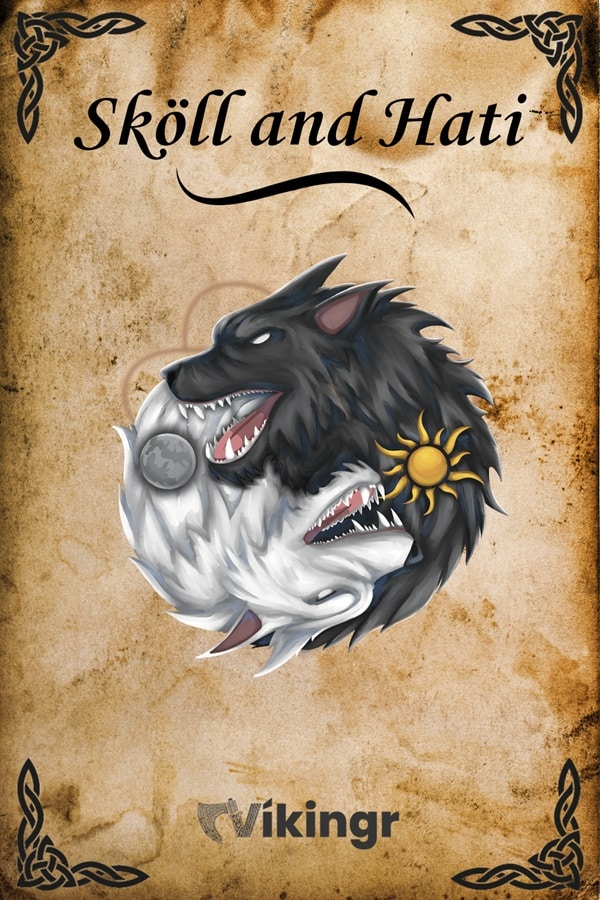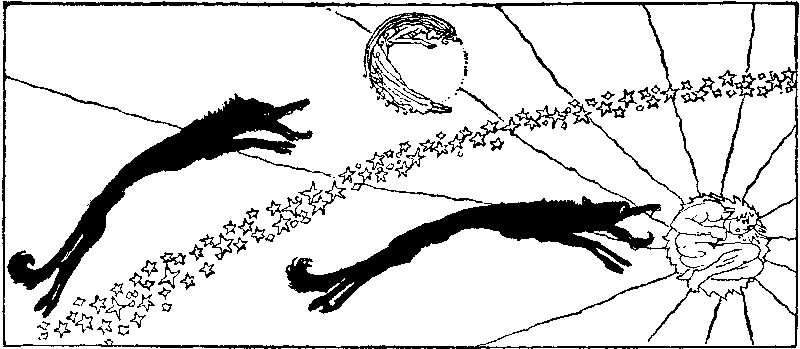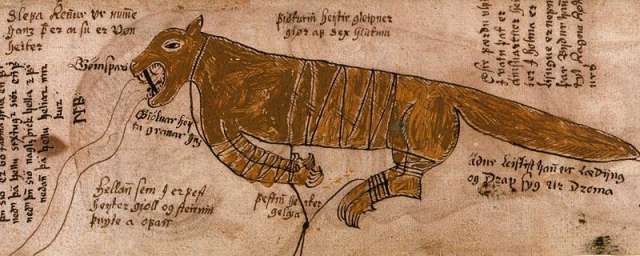Sköll and Hati are the two giant wolves that forever are chasing the moon and sun across the sky. Most likely fathered by Fenrir, they pursue their prey with intense devotion. When they finally succeed, it will signal the beginning of Ragnarok, and the end to all.
Origins of Sköll and Hati
Born into the world by an ancient jötun witch and the monstrous Fenrir wolf, Sköll and Hati were always destined to be infamous. Little however is known about their mother, other than her being an old jötun living in a forest called Ironwood.
Having said that, there are a couple of things that point to their mother being Angrboda, whom is also Fenrir’s mother.
From the Völuspá;
“East sat the crone, in Iârnvidir, and there reared up Fenrir’s children: of all shall be one, especially the sun’s devourer, in a troll’s semblance.”
Who is the Father of Sköll and Hati?
The popular position is that Fenrir is the father of Sköll and Hati. As seen already, the Völuspá names Fenrir as the father of the one who will devour the sun.
I’m diving into which of the wolves actually chases the sun and which chases the moon below. However, in a stanza from Grimnismal I am quoting, Hati is called: “Hati, son of Hróðvitnir”. The Old Norse Hróðvitnir (Fame-wolf) used here is uncannily similar to the Old Norse Hróðrsvitnir (Famous-wolf) which is used as a name for Fenrir in the Poem Lokasenna stanza 39:
Tyr spoke:
“My hand do I miss, | but you Hrothvitnir,
And the loss brings longing to both;
Ill fares the wolf | who shall ever await
In chains the fall of the gods.”
Seeing as Sköll and Hati ends up playing such a big part in the build-up to Ragnarok it also seems fitting they have a certain pedigree.
Which Wolf Chases the Moon and Which Chase the Sun?
While the sources are slightly contradictory, it is fairly certain that Sköll is chasing Mani (the moon), and Hati is chasing Sol (the sun). As is so often the case in Norse mythology, there are various sources and they are not always in agreement.

According to Snorri in Gylfaginning (Prose Edda)
In Snorri Sturluson’s Prose Edda, in the Gylfaginning, he states that it is the other way around. That Sköll is chasing the sun and Hati is the one chasing the moon. From chapter V. of the Gylfaginning:
“Then asked Ganglere: Who causes her this toil? Answered Har: It is two wolves. The one is named Sköll, he runs after her; she fears him and he will one day overtake her. The other is named Hati, Hrodvitnir’s son; he bounds before her and wants to catch the moon, and so he will at last.”
So from the Gylfaginning, we are told that it is Hati that chases the moon, and Sköll the sun. However, Snorri had to have gotten his facts from the poems of the Poetic Edda which doesn’t support this.
According to the Poetic Edda
Much like Snorri Sturluson himself, we can go back to the Poetic Edda for “facts”. Actually, after centuries of fascination and studies of Norse mythology, we might have a better grasp of the facts according to the Poetic Edda today than Snorri ever had.
In Grímnismál stanza 39 we learn that it is Sköll who chases the “shining god” and that Hati chases the “bride of heaven”.
“Sköll is the wolf who pursues the shining god to the protective woods.
Another is Hati, son of Hrothvitnir, chasing the bright bride of heaven”.
As Mani (moon) is the masculine, and Sol (sun) is feminine, it is in fact Hati who is chasing the sun across the sky. Snorri might have mistaken the two when he wrote the Gylfaginning. Possibly just exercising some creative freedom for poetic effect, not expecting to be held accountable eight hundred years later.
Are Sköll and Hati Norse gods?
Sköll and Hati are not gods, they are closer to monsters of Norse mythology. While many of the gods are in fact half jötun, they are still clearly of the Aesir or Vanir tribes.
The wolf brothers on the other hand are beasts with all jötun lineage. As such they represent chaos and are among the forces the gods fight against.
Who are Sköll and Hati chasing?

The prey that the wolf brothers hunt are Sol and Máni, the drivers of the sun and moon chariots. Destined to forever run across the sky, Sol and Máni are sister and brother.
Originally, mere mortals, they are close to, or actual Aesir gods. In fact, Sol is listed as such in an anonymous poem listing names of the Asynjur (Aesir goddesses);
‘Now all the Ásynjur shall be named: Frigg and Freyja, Fulla and Snotra, Gerðr and Gefjun, Gná, Lofn, Skaði, Jǫrð and Iðunn, Ilmr, Bil, Njǫrun.’
‘Hlín and Nanna, Hnoss, Rindr and Sjǫfn, Sól and Sága, Sigyn and Vǫr; then there is Vár, and Syn must be named, and Þrúðr and Rán [are] listed next to them.’
Their Connection with Solar Eclipses
When doing research for this post I have come across several mentions of the Vikings connecting them with solar eclipses. I have thus far been unable to find an actual source for this supposed belief, but it absolutely sounds plausible.
In most old cultures, explanations for various celestial and natural phenomena were to be found in their mythology. This is the case with Norse mythology as well. Some examples are the rainbow being the Bifrost bridge, Thor creating thunder and Loki writhing in pain causing earthquakes.
That they needed and found, explanations for something as spectacular as a solar eclipse in their mythology stands to reason.
As legend has it a solar eclipse occurred because Hati caught up with the sun, trying to swallow it. Then it is said that Vikings would holler and make loud noises to scare Hati away.
Thankfully, that strategy seems to have worked so far, maybe something to remember next time you witness an eclipse!
Featured Image Credit: John Charles Dollman, Public domain, via Wikimedia Commons

